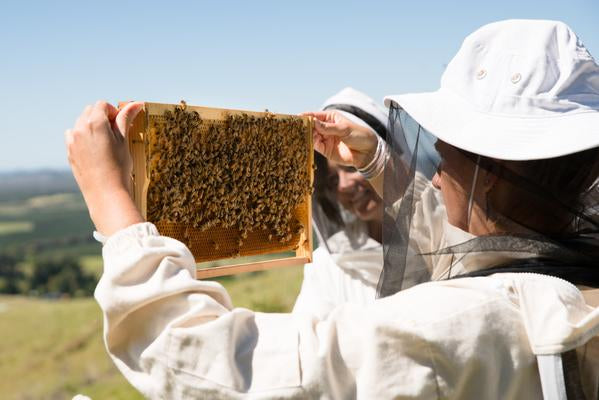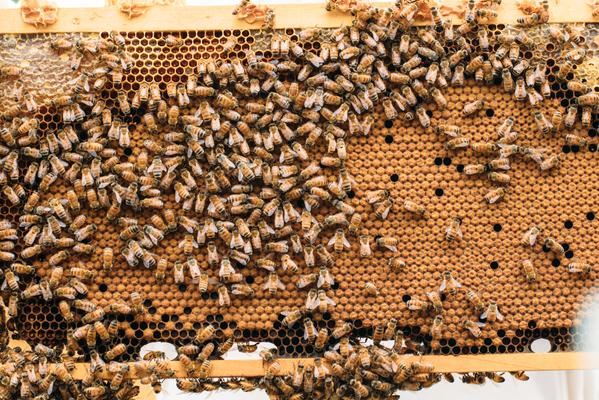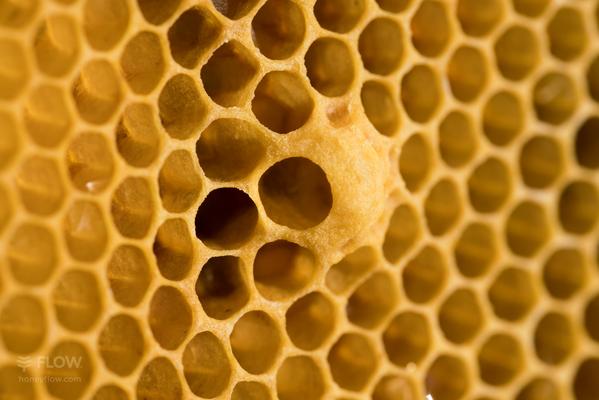Your Cart is Empty
🐝 Free garden tools with Flow Hive orders. T&Cs apply. Shop now
🐝 Free garden tools with Flow Hive orders. T&Cs apply. Shop now
Colony management – frequently asked beekeeping question
by Flow Hive 7 min read
Although harvesting with a Flow Hive drastically reduces the amount of labour in harvesting honey compared to traditional methods – most other aspects of caring for you colony will remain the same.
Here are some frequently asked questions about colony management, answered for you!

What do I do if I have particularly aggressive bees?
Sometimes colonies can be aggressive if they are queenless, at other times particular nectar sources can make bees more prone to defensive behaviour, while sometimes they may react strongly if you’re inspecting them in a bit of a bumpy manner (which may not affect other colonies).
If you are finding that your bees are consistently aggressive, and you’ve ascertained that your hive is not queenless, it is not what flowers they are feeding on, and your bees respond in this manner regardless of your beekeeping style, it may be a case of needing to requeen. Requeening can bring in different behavioural traits—check in with the queen breeder about whether your replacement queen is a gentle one.
What do I do if my hive is weak or struggling?

You need to first of all ascertain why it is that your hive is weak—could it be the time of year? Should your colony be in their expansion phase? (i.e. in spring or summer) If yes, then do a full brood inspection.
Some things to look out for:
Are there pests or disease present?
This may affect the health of your colony—you must treat any pests or diseases as per the legal requirement of your department of primary industry.

Is the queen present?
Can’t find her? Look for a good brood pattern and different stages of eggs, larvae, pupae and brood.
No? Maybe your queen is either not present (and something has happened to her 😞), infertile or not laying. Check out our blog for more info.
Without a healthy, robust fertile queen, your hive will be low in numbers and may be struggling. You may need to requeen.

Food
Is there enough forage available? You may need to supplement their feed.
Location
Have you chosen a sheltered position for the hive which is away from prevailing winds (especially the entrance)? In cool climates it should be in a dry sunny position, and in hot climates the hive will benefit from some shade, particularly in Summer. Ideally, face the entrance in a southerly direction if you’re in the northern hemisphere and northerly direction for the southern hemisphere.
Pesticide
It is possible that your bees may have been poisoned by pesticides.
There may be a multitude of other reasons – sometimes a colony's strength can even vary within the same apiary.
If you are unsure, we recommend checking with your local experienced bee mentor or beekeeping club/association.
Can I (indefinitely) reuse brood comb?
You can reuse the same brood comb within the same colony for a few years, however after this timeframe, you may consider replacing the brood frames, as the internal diameter of each cell will become progressively smaller over time – even though the nursery bees will clean out each cell, remnants of the cocoon will still be glued to the cell wall.
Residues of pesticides and disease organisms can also remain inside the wax – it is therefore recommended to cut away very dark old comb (or just replace the entire frame) to make a healthy environment for your baby bees. Make sure to do this before spring when the hive is building it’s numbers and expanding.
Feed colony during drought?
During a dearth of nectar, it may be important to feed your bees with supplementary food. If there is a drought, make sure to check whether your bees have enough stores, and also make sure they have a clean water source.
Do not feed your bees honey (unless it is their own) due to risk of contamination (or it not being real honey!). Most beekeepers choose to feed a sugar solution. Check in with local experienced beekeepers and beekeeping clubs/associations what they recommend.
How to prevent cross-comb

The best way to prevent cross-combing is to avoid them in the first place with comb guides, and importantly by performing routine inspections as the comb is being built out. If you see the comb being built out of place you can easily nudge it back on course when the comb is still fresh.
You can also use wax foundation for the bees to build out from.
Read more about cross combing on our FAQ here and read more on foundationless frames here.
How do I prevent my hive from swarming?

Swarming is when the old queen bee leaves the hive with 10-30 000 worker bees in search of a new home. This is a natural evolutionary behaviour for bees – they do this every year in spring.
Some beekeepers consider it poor practice to let your hive swarm; as you effectively lose half the population of your colony—and the swarming bees gorge themselves on honey before leaving in search of a new home—it can leave the colony left behind less strong and robust, taking them more time to rebuild their numbers, which means you mightn’t have the chance to harvest honey in this season (depending on your season).
Swarming can also spread pests and diseases and result in unmanaged feral colonies (if you don’t manage to capture your swarm) – which can further exacerbate pests and diseases.
You can attempt to prevent your hive from swarming by taking precautionary measures.
As the weather warms up you want to:
- Check that your bees have enough room in the brood box. You may want to add another brood box, make a split from your hive, or consider rotating the brood frames to create more space by adding empty brood frames into the brood box.
- If the timing is right, adding your Flow Super is also a good way to create more space. Check for queen cups and queen cells. Red alert for swarming preparation! You will need to do a split at this stage, if your bees have not already swarmed.
- Check for queen cups and queen cells. Red alert for swarming preparation! You will need to do a split at this stage, if your bees have not already swarmed.

Queen cup – acorn-like bulge on the surface of the frame. This can be an indicator the colony is getting ready to swarm.

Queen cells. A sure sign your hive is trying to reproduce a new queen. Either your bees are about to swarm, or they already have.
Read more about what to do in preparation for spring here.
Sometimes bees may also swarm outside of spring, so it is important to keep an eye on your colony during your regular brood inspections throughout spring and summer.
Should I have more than one brood box? How and when do I add this?
Some beekeepers recommend having more than one brood box in colder climates, or for if you want to expand your colony in warmer climates.
Having more than one brood box (generally two is considered the norm) to take you into winter in cold climates can mean your colony is more likely to survive through the depths of winter. It also means they are more likely to thrive in the next season, and be strong and prolific in gathering and storing nectar.
It can also mean the bees can collect enough food for themselves over winter. It is recommend to go into winter with a least a full super of honey, if you are not going to feed your bees. Read more about overwintering here.
To add an extra brood box to your hive make sure your first brood is almost overflowing with bees – you want at least 90% of the brood frames to be completely built out. Then add the next brood box on top, as you would the Flow Super, keeping the queen excluder above the new brood box when you go to add your Flow Super.
It’s also possible to add a second brood box once the Flow Super is already in place, however, you may see less activity in your super while the bees build out the brood frames below. The bees may even move honey stored in the Flow Frames down to the brood boxes temporarily, however, once the second brood box has been built out in full, the bees should resume activity in the Flow Frames and Super.
How to know when your brood box is ready to have another box added:
- You need to open up the brood box—please take safety precautions and use the appropriate safety gear
- It is important to install your bees in the brood box and wait until they are fully established before adding the next brood box. This can take anywhere between 1-8 weeks (longer if conditions are not favourable), depending on whether you have a nuc or package of bees, and will vary greatly depending on the time of year and the local resources available for your bees.
- We supply foundationless frames with our brood boxes, as we think it’s beneficial for the bees to build their honeycomb from scratch. Many beekeepers also use foundation in their frames as it requires less maintenance when the bees are first establishing themselves in the brood box. When using foundationless frames it’s a good idea to inspect the brood box whilst the colony is building the comb to prevent the bees building cross combin the frame. This way if they have run off course, you can gently nudge the comb back in place.
- Remember to keep all of the brood frames tightly together towards the centre of the box. If there is an extra space this should be distributed evenly on the outer edges of the brood box to further reduce the risks of cross comb. For best results, it is recommended that you check to ensure that all 8 brood frames have been drawn out and contain substantial comb before adding the next brood box. The combination of a full brood box and a significant amount of bees will help to encourage your bees to make fast progress on the next brood box, and subsequently Flow Super.
As always, we strongly recommend checking in with local experienced beekeepers for recommendations. But remember—ask two beekeepers and get three different answers!
Have more colony management questions you’d like answers to? Email, chat or call us today!



